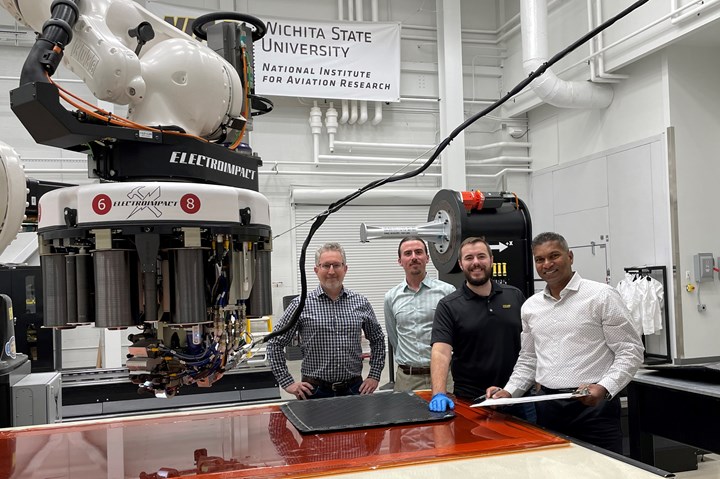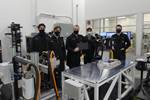NIAR-WSU, Victrex begin NCAMP materials and process qualification for AFP
In-depth investigation into AFP machine variability on composite allowables begins on carbon fiber-reinforced thermoplastic (CFRTP) test panels to achieve certification framework.

(Left to right): David Mollenhauer, AFRL; Kevin Rogers, Victrex; Isaac Schmitz and Waruna Seneviratne, WSU-NIAR. Photo Credit: WSU-NIAR
After several months of joint effort, Victrex (Lancashire, U.K. and Conshohocken, Pa., U.S.) and the (NIAR) at Wichita State University (WSU, Kan., U.S.) have developed material and process specifications for automated fiber placement (AFP) systems according to NCAMP protocol.
NCAMP, the university’s National Center for Advanced Materials Performance, works with the Federal Aviation Administration (FAA) and industry partners to qualify material systems and populate a shared materials database that can be viewed publicly.
NIAR’s Advanced Technologies Laboratory for Aerospace Systems (ATLAS) has begun manufacturing test panels using Victrex AE250 polyaryletherketone (PAEK), a thermoplastic material system reinforced with IM7 carbon fibers. This is a part of the Modeling for Affordable Sustainable Composites (MASC) program, sponsored by the Air Force Research Laboratory (Wright-Patterson Air Force Base, Ohio, U.S.). MASC focuses on developing a certification framework for enabling novel materials and advanced structural concepts used for automated manufacturing technologies.
According to NIAR-WSU, this is the first time a program has conducted an in-depth investigation into the variability of multiple AFP machines on the composite allowables generated using industry-standard statistical procedures outlined in Composite Materials Handbook 17.
The project includes qualification of several thermoset, thermoplastic and dry-fiber AFP material systems from Hexcel (Stamford, Conn., U.S.), Solvay (Alpharetta, Ga., U.S.), Toray (Morgan Hill, Calif., U.S.) and Victrex. All of the data and associated documents will be included in the NCAMP shared material database.
In order to mitigate risks due to machine variability, a series of pre-qualification manufacturing trials were conducted to develop machine programming protocols to manufacture equivalent panels across various AFP machines. These machine agnostic allowables can then be used by a wide variety of certification programs regardless of the type of AFP machines used for production. The AFP panel manufacturing kickoff was witnessed by NCAMP airworthiness representatives and personnel from the Air Force Research Laboratory and Victrex.
Related Content
-
Composites end markets: Sports and recreation (2025)
The use of composite materials in high-performance sporting goods continues to grow, with new advancements including thermoplastic and sustainability-focused materials and automated processes.
-
Update: THOR project for industrialized, recyclable thermoplastic composite tanks for hydrogen storage
A look into the tape/liner materials, LATW/recycling processes, design software and new equipment toward commercialization of Type 4.5 tanks.
-
Braided thermoplastic composite H2 tanks with co-consolidated molded boss areas to fit EV battery space
BRYSON project demonstrates possible designs, automated manufacturing and low permeability concepts, including EVOH liner and novel PPA matrix.






